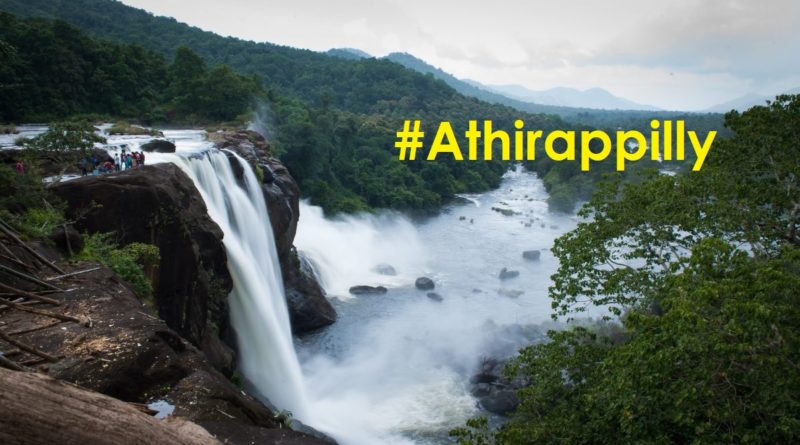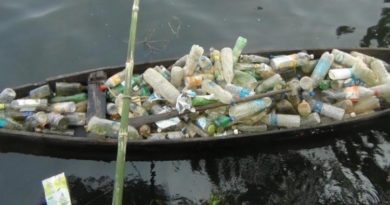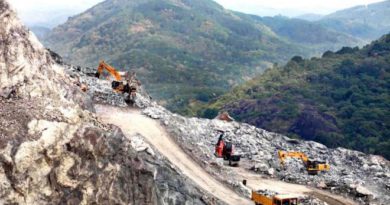Kerala’s Athirappilly Hydel Power Project Is a Recipe for Disaster
Thanks to the Right to Information (RTI) Act, the Western Ghats Ecology Expert Panel (WGEEP) was made public. Chaired by noted environmentalist, Madhav Gadgil, it reveals stringent norms for development in ecologically sensitive areas of different degrees.
As for Kerala, WGEEP recommends that no new dams based on large-scale storage be permitted in Ecologically Sensitive Zone 1 as defined by the Panel. Since Athirappilly hydel project sites fall in Ecologically Sensitive Zone 1, this project should not be accorded environmental clearance.
Despite this, Kerala’s Athirappilly hydel power project has been the issue of fierce controversy.
The Kerala State Electricity Board (KSEB) proposed a hydroelectric dam across the Chalakudy River in Trichur district in Kerala, to generate 163 MW of power. Such was the defiance and arrogance that the then Kerala’s chief minister has termed opponents to this project as ‘anti-developmentalists’.
He and the KSEB were fighting with all their might to ensure that the dam is constructed, never mind the ecological devastation. Environmentalists, local tribal leaders and non-government organisation (NGOs) have fought back tooth and nail to stop this project but their efforts at every stage have been nullified by the political leaders.
Following are excerpts from the WGEEP Report, which will give you an insight into how the powers-that-be defy every environmental norm under the name of development and also tells you about the invaluable natural treasure that this project will destroy forever. Needless to say, like lakhs and lakhs of Keralites, it is the common man who will bear the heavy brunt of the politicians’ care a damn attitude towards environment.

The Athirappilly hydel power project as scrutinised by the WGEEP:
WGEEP proposes that environmental clearance should not be given to any large-scale storage dams in eco-sensitive zone (ESZ) 1 and ESZ 2. The location of Athirappilly dam falls in ESZ 1. Hence, we recommend that the Ministry of Environment and Forests (MoEF) refuse environmental clearance to it. WGEEP further notes that the process of proper assignment of rights under the Scheduled Tribes and other Traditional Forest Dwellers (Rights over the Forest) Act has not been completed and it is therefore quite improper to accord environmental or forest clearances.
The Union ministry of environment and forests gave forest clearances in two phases in 1997 and 1999 and environmental clearance in 1998. The High Court of Kerala suspended all the three sanctions based on several public interest litigations (PILs), because of the MoEF’s violation of the Environmental Protection Act and controversial tendering process.
The High Court directed the Central government to withdraw the sanction given earlier and conduct a public hearing in accordance with the environment impact assessment (EIA) notifications of the MoEF and reconsider the environmental clearance given.
Accordingly, a public hearing was conducted by the Kerala State Pollution Control Board in February 2002 by the Tropical Botanical Gardens and Research Institute (TBGRI). The public hearing panel asked for a second EIA, which should be comprehensive. The KSEB engaged Water and Power Consultancy Services India Ltd (WAPCOS) in January 2002 to conduct a comprehensive environment impact assessment (CEIA).
Their report was questioned by the Chalakudy Puzha Samrakhna Samithi (Chalakudy River Protection Council) on various grounds like its period of study, consultations with various agencies (local bodies, various departments of the government and the local communities) suggested by the High Court, methodology, and scientific reliability.
The Kerala State Biodiversity Board (KSBB) in an affidavit filed in the High Court categorically stated that the EIA report of WAPCOS was not comprehensive, and that the methods followed for the biodiversity studies were wrong and unacceptable. There was no indication that WAPCOS had any consultation with the agencies suggested by the public hearing panel.
However, the KSEB went ahead and obtained the clearance from the MoEF in February 2005.
Another PIL was filed by the Athirappilly Gram Panchayat and the Kadar tribals, the actual potential sufferers of the proposed dam, challenging the sanction accorded by the MoEF, mainly on the ground that the report of the second EIA was not circulated and kept away from the public and that there was no public hearing on the second EIA. The Division Bench of the Kerala High Court by its order on 23 March 2006 quashed the environmental clearance given by the MoEF in February 2005 and asked the Kerala State Pollution Control Board to conduct a public hearing after publishing the environmental assessment report stated to have been prepared by the KSEB.
Thus, the second public hearing on the proposed Athirappilly hydro-electric dam was conducted on 15 June 2006 at Chalakudy in Trichur. According to the written submission made by Chalakudy Puzha Samrakshana Samithi to the WGEEP, more than 1,200 people attended the public hearing where none spoke in favour of the Project and, in the 252 written representations submitted to the public hearing panel, the ratio for and against the project was 1:9, respectively. The Samithi further stated that the minutes of the public hearing panel was not unanimous. Of the five members, three were against the Project and among them two happened to be the Presidents of Athirappilly Gram Panchayat and Chalakudy Block Panchayat, representatives of the people from the two Panchayats, who would be affected directly by the construction of dam.
Pressure from civil society mounted up again, against the project. A five member Environment Appraisal Committee (EAC) of the MoEF visited the dam site and related areas, and had discussions with those opposing the project as well as officers of the KSEB at Athirappilly in April 2007. It also conducted a Public Hearing at the Town Hall, Trichur the following day. The then Chairman of the KSBB was also present at the meeting.
Members of the Committee did not seek any clarification on the points raised by those objecting to the project. Instead it was just another Public Hearing.
Based on the report of this Committee, the Expert Committee for River Valley projects of the MoEF gave clearance for the project on 18 July 2007.
PILs were filed again by one Geetha, representative of the primitive Kadar tribe, and CG Madhusoodhanan, a hydrology engineer. Ms Geetha challenged the project on the ground of ecology and biodiversity and the impact on their life-support system, while Madhusoodhanan challenged the WAPCOS EIA per se and the hydrological data base used in the WAPCOS study.

The Kerala State Biodiversity Board discussed the issue in detail and took a decision against the Project considering the rich biodiversity of the area and filed an affidavit at the Kerala High Court as KSBB has been made a Respondent.
The Kerala High Court heard the case twice, in 2008 and in 2009, by two Division Benches.
On mounting pressure from the Government of Kerala for the clearance from the MoEF, it has asked the WGEEP to examine the issue, along with a few other projects proposed in the Western Ghats, and give recommendations. However, the WGEEP recommendations were subsequently thrown to the winds.
WGEEP’s visits:
- The WGEEP visited the proposed dam site, the reservoir area, the primitive tribal settlements at Pokalappara and Vazhzchal, its surroundings and, the downstream Thumburmuzhi major Irrigation project (Chalakudy River Diversion Scheme) on 29 January 2011.
- It had consultations at various levels; with the representatives of the primitive Kadar tribe at the site, the local Panchayat (Athirappilly Panchayat), and the general public, who responded to the WGEEP’s press note inviting those interested to come and give their views.
- In addition to these, the WGEEP organised a technical consultation, which was attended by experts from the KSEB, Chalakudy Puzha Samrakshana Samithi, River Research Centre, Kerala Sastra Sahithya Parishath (KSSP), Kerala Forest Research institute (KFRI), Kerala State Biodiversity Board, TBGRI, and Nature Conservation Foundation (NCF). Officers from Kerala State’s departments of Irrigation, Tribal Department, and Forest & Wildlife, Tourism section, retired forest officers, Vana Samrakhana Samithi, and KSEB’s Officers’ Association were also present. It goes to the credit of the WGEEP that this was the first time that such a discussion was held between the proponents and opponents of the Project.
- The WGEEP heard the views of all sections and individuals and, the Chairman, WGEEP requested the KSEB and all other participants that if they had any additional information or more detailed answers to questions raised by both the parties, they may send them to the Chairman by e-mail or post.
- WGEEP’s conclusions were based on the views expressed by and the written representations received from the local primitive tribal community, Athirappilly Panchayat, the general public, technical experts including the officers of the KSEB, the detailed minutes of the 14th meeting of the Kerala State Biodiversity Board held on 26 September 2007, the EIAs conducted by the TBGRI (1996) and WAPCOS (2002), the results of the three public hearings as given in the minutes of the KSBB, technical details of the project explained by the KSEB, questions raised on the technical feasibility of the project, alternatives for power and the alternatives suggested by the Kerala High Court in its judgment of 17 October 2001.
WGEEP’s conclusions:
1. Unique riverine forest ecosystem: The riparian vegetation in the Chalakudy river system is unique in that there is no such riparian vegetation at such low elevations anywhere else in the Western Ghats, especially in Kerala.
2. High endemism in the riparian vegetation: The riparian vegetation in the proposed dam site contains 155 species of endemic plants and more than 33 species of plants belonging to the Rare, Endangered and Threatened categories of International Union for Conservation of Nature (IUCN).
3. Richness in endemic, endangered species: The project area has a high degree of endemic species of several taxa: 21% of plants (out of 508 spp.), 16% of butterflies (out of 54 spp.), 53% of amphibians (out of 17 spp.), 21% of reptiles (out of 19 spp.), 13% of birds (out of 98 spp.) and, 14% of mammals (out of 22 spp.) recorded in the area are endemic species (WAPCOS EIA 2002).
4. Critically endangered plants: Critically endangered riparian trees such as Syzygium occidentalis and Atuna travancorica occur in the area.
5. Rare species of plants in Kerala: Gymnema khandalense was reported in Kerala only from Athirappilly. A new species of plant, namely Lagenandra nairii is reported only from Athirappilly.
6. Habitat connectivity: The riparian vegetation of the Vazhachal-Athirappilly area serves as a link between the varied habitats at lower and higher elevations.
7. The very high conservation value: According to the Biodiversity Conservation Strategy and Action Plan for Kerala prepared by the French Institute, Pondicherry, the conservation value of the Vazhachal (project area) is as high as 75%. The KFRI, in a recent study, has also classified Vazhachal area as a High Value Biodiversity Area and has brought out a detailed Biodiversity Management Plan for it.
8. Unique area for bird conservation: i) Of the 486 species of birds recorded from Kerala, 234 are sighted in the Vazhachal-Athirappilly area, ii) all the four species of hornbills found in Kerala, namely Malabar Grey Hornbill, Grey Hornbill, Malabar Pied Hornbill, and Great Indian Hornbill occur in the Athirappilly-Vazhachal area; a very rare phenomenon, iii) riparian forests of the area constitute one of the only two breeding sites of the Malabar Pied Hornbill in Kerala, the other being Aralam Wildlife Sanctuary, iv) 12 of the 16 species (75%) of the endemic species of birds seen in the Western Ghats are present in the Athirappilly-Vazhachal area.
9. Important Bird Area (IBA): The Vazhachal-Sholayar area has been identified as a globally Important Bird Area in 1995 by Birdlife International, Cambridge.
10. Extremely high fish diversity: Out of the 210 species recorded in Kerala, the Chalakudy River has 104 species including 22 Endangered and 9 Critically Endangered species
11. New species of fish: The fish fauna of the Chalakudy River is unique in that there are as many as five new species, namely Osteochilichthys longidorsalis, Travancoria elongata, Horabagrus nigrocollaris, Puntius chalakudiensis, and Salarias reticulatus were discovered for the first time from the Chalakudy River
12. An extremely rare species of fish: The population of one fish species (Osteochilichthys longidorsalis) found only in the Chalakudy river has reduced 99% during the last two decades.
13. Fish abundance in the project area: In a single study, out of the 99 species of fish recorded in the Chalakudy River, 68 were from the project area.
14. Breeding area of fish: Athirappilly-Vazhachal area provides microhabitats for various species of fishes to breed.
15. Fish migration: Some of the species of fish migrate upstream while some do so downstream to complete their annual life cycle. Hence, construction of the dam will directly affect the survival of these species.
16. Chalakudy River as a Fish Sanctuary: Considering the rich fish diversity and its other various importance as given above, the National Bureau of Fish Genetic Resources has recommended the Chalakudy River to be declared as a Fish Sanctuary.
17. Loss of microhabitats of amphibians: Some amphibians such as the torrent frog Micrixalus saxicolus recorded from the area are confined only to the boulders submerged in the water course would lose their habitat by commissioning this project.
18. Elephant Reserve: The entire project area falls within the Elephant Reserve No9 identified by the MOEF under ‘Project Elephant’.
19. Migratory route of elephants: The submergence area is within the migratory route of elephants from Parambikulam plateau to Pooyamkutty forests.
20. Presence of the rare Lion-tailed Macaque: One troop containing around 13 individuals of the Lion-tailed Macaque, an endemic, endangered species of the Western Ghats, lives in the riparian vegetation of the submergence area.
21. Ideal habitat of the rare Cane Turtle: The cane turtle, an endemic and endangered
The Background of RTI’s role in making the report public:
Invaluable work done has been done by the Western Ghats Ecology Expert Panel – WGEEP of the Western Ghats, which has one of the 34 global biodiversity hot spots and spread across a whopping 1.29 lakh odd square kms. The Western Ghats is spread over six states—Tamil Nadu, Kerala, Karnataka, Goa, Maharashtra and Gujarat. Curiously, it was the MoEF, which instituted this study, but after completion and assurance by the Ministry that the report would be made public in September 2011, it suddenly clamped up. Naturally, as the vested interest in mining, construction, making roads and railways and so on in all of these States, would be at a disadvantage.
So, G Krishnan, a resident of Kerala, invoked the RTI in November 2011 at the MoEF office. He asked for the copy of the WGEEP report under Section 6 of the RTI Act. The Public Information Officer (PIO) denied information stating that the MoEF was still in the process of examining the report in consultation with six state governments of the Western Ghats region.
Krishnan then filed a first appeal with the Appellate Authority of the MoEF but here too he was denied information stating that “it comes under Section 8” (information can be denied in this section for various reasons—here it was cited as compromising with economic interests of states, which was indeed laughable).
Krishnan then filed a second appeal with the Central Information Commissioner Shailesh Gandhi in New Delhi. The PIO reasoned that “views from 11 ministries, the Planning Commission and six states were being sought. Therefore, disclosure of information at this stage would lead to various proposals as per the recommendations of the report which had not been finally accepted. This would affect the economic interests of the state.” The CIC in its order on 9 April 2012 asked MoEF to provide copy of the report by 5 May 2012 and put it up on the website by 10 May 2012. (Read: RTI Judgement Series: When the Western Ghats ecology status report was made public)
Not satisfied with the CIC decision, the MoEF sought legal intervention. It filed a petition with the Delhi High Court in first week of May. The MoEF argued that “a host of information in relation to the minutes of the meeting and report of the Madhav Gadgil Committee are already uploaded on the website—www.westernghatsindia.org”.
The submission raised by the MoEF that providing a copy of the report would harm the economic interests of the state was demolished by the judge who stated that, “It must be remembered that the object and purpose of governance in a democracy is to fulfil the will of the people.” It ordered that the report should be made public and finally it did thanks to the RTI Act.
Originally published by https://www.moneylife.in/ by Vinita Deshmukh
(Vinita Deshmukh is consulting editor of Moneylife, an RTI activist and convener of the Pune Metro Jagruti Abhiyaan. She is the recipient of prestigious awards like the Statesman Award for Rural Reporting which she won twice in 1998 and 2005 and the Chameli Devi Jain award for outstanding media person for her investigation series on Dow Chemicals. She co-authored the book “To The Last Bullet – The Inspiring Story of A Braveheart – Ashok Kamte” with Vinita Kamte and is the author of “The Mighty Fall”.)




